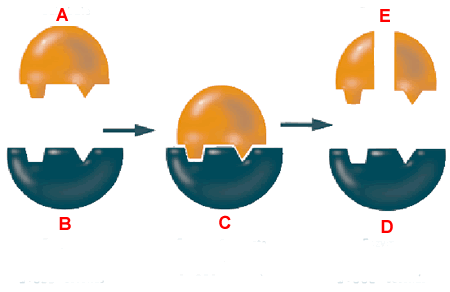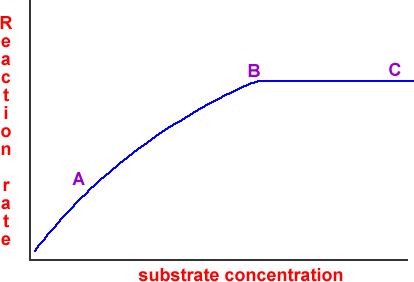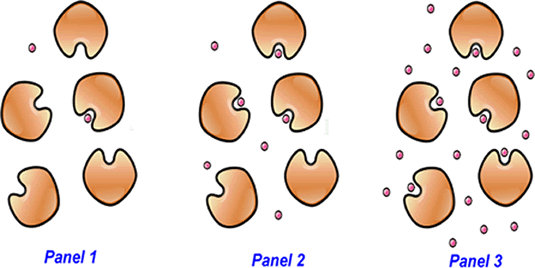- Enzymes speed up a reaction by
- lowering activation energy
- increasing temperature
- creating more reactants
- increasing activation energy
- In a reaction between the sugar maltose, and the enzyme maltase, which catalyzes the decomposition of maltose
- maltose is the substrate
- maltase is the substrate
- maltase is the product
- water is the substrate
- maltose is the product
- Which of the following is NOT true?

The substrate is
The enzyme is
The enzyme-substrate complex is
The product is- labeled "A"
- labeled "B"
- labeled "C"
- labeled "D"
- labeled "E"
- The part of the enzyme where the substrate binds is known as the
- catalyst
- active site
- inhibitor
- activation energy
- Cells must produce many different enzymes because
- enzymes are quickly used up
- most cellular reactions require a specific, unique enzyme
- they have to have some way to use up the protein that they consume
- enzymes are not very effective at speeding up reactions
- Enzyme names always end with the suffix
- -ase
- -ose
- -ene
- -ite

What phenomenon explains the flat area on the graph between points B and C?- the reaction has come to a stop
- all of the enzyme's active sites are occupied
- the reaction has run out of substrate
- the enzyme has stopped working

Which of these changes might increase the rate of the reaction beyond point C?
In the area marked A on the graph, many of the enzyme molecules have active sites that are- available for substate binding
- occupied by inhibitors
- damaged

Which of the following changes might cause a decrease in the rate of the reaction beyond point C?- addition of more substrate
- addition of an inhibitor
- a decrease in temperature
- a change in pH
- an increase in temperature
- addition of more enzyme molecules
- Without the presence of enzymes, the reactions necessary to sustain life would require ___________________ in order to occur.
- much larger cells
- more organelles
- larger proteins
- higher temperatures
- When a piece of liver is dropped into hydrogen peroxide, the peroxide bubbles vigorously as the hydrogen peroxide (H2O2) decomposes into water (H2O) and oxygen (O2). This rapid change in reaction rate suggests
- that liver contains lots of germs
- the liver contains an enzyme that breaks down hydrogen peroxide
- that liver is a substrate for hydrogen peroxide
- that hydrogen peroxide is a powerful enzyme
- When a piece of liver is dropped into hydrogen peroxide, the peroxide bubbles vigorously as the hydrogen peroxide (H2O2) decomposes into water (H2O) and oxygen (O2). However, if the liver is cooked first, the reaction fails to occur. The reason for this is
- heating kills the germs that cause the bubbling
- heating damages the enzyme in liver that breaks down hydrogen peroxide
- heating removes the water and oxygen from the liver
- reactions take place faster at lower temperatures

Which panel represents the saturation of the enzyme by the substrate?- Panel 1
- Panel 2
- Panel 3

Which panel represents the reaction at its maximum rate?- Panel 1
- Panel 2
- Panel 3

In what way could you increase the rate of the reaction as it is taking place in Panel 3?- Add more substrate
- Remove substrate
- Add more enzyme molecules
- Remove enzyme molecules
- Add more water